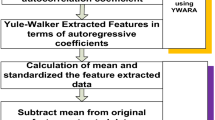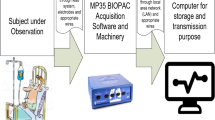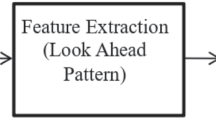Abstract
Electrocardiogram (ECG) is a non-invasive test which is highly adopted as a primary diagnostic tool for cardiovascular diseases. ECG recording appears as a non-stationary and quasi-periodic electrical signal. This electrical signal has important segments: P-wave, QRS-complex, and T-wave. R-peak is an important component of these segments. Computer-aided diagnosis is preferable as manual diagnosis using naked eye may mislead the detection. Therefore, in this paper, features extracted using both Burg method of autoregressive (AR) modeling and Hilbert transform are used for enabling efficient automated R-peak detection in ECG signal. Burg method is considered for extracting features due to its better frequency resolution, flexibility in selecting AR model orders and faster convergence for short-time signals. Next, Hilbert transform is used to find missed information in terms of the spectral components. The proposed technique is validated using Massachusetts Institute of Technology-Beth Israel Hospital Arrhythmia database. K-nearest neighbor (KNN) classifier is used for classification as it requires only few parameters to be tuned (K and the distance metric). In this paper K = 3 is selected to avoid any tie situation and Euclidean distance metric is selected because it does not require any weights for features. Also, KNN is more effective for classifying three classes as compared to those handled by other existing classifiers. The performance of the proposed technique is evaluated on the basis of sensitivity (Se), positive predictivity (PP), accuracy (Acc) and duplicity (D). The proposed work yielded Se of 99.90%, PP of 99.93%, Acc of 99.84%, and D of 0.006361%. These results indicate improvement in heart diagnostic leading to correct treatment of the subject (patient) over other existing state-of-the-art methods.













Similar content being viewed by others
References
B. Vishwanath, R.V. Pujeri, G. Devanagavi, Probabilistic principal component analysis-based dimensionality reduction and optimization for arrhythmia classification using ECG signals. Bio-Algorithms Med-Syst. 15(1), 1–15 (2019)
S.S. Mehta, N.S. Lingayat, SVM-based algorithm for recognition of QRS complexes in electrocardiogram. IRBM 29, 310–317 (2008)
Z. Wang, F. Wan, C.M. Wong, L. Zhang, Adaptive Fourier decomposition based ECG denoising. Comput. Biol. Med. 77, 195–205 (2016)
S. Jain, M.K. Ahirwal, A. Kumar, V. Bajaj, G.K. Singh, QRS detection using adaptive filters: a comparative study. ISA Trans. 66, 362–375 (2017)
S.S. Mehta, D.A. Shete, N.S. Lingayat, V.S. Chouhan, K-means algorithm for the detection and delineation of QRS-complexes in electrocardiogram. IRBM 31, 48–54 (2010)
S. Ari, M.K. Das, A. Chacko, ECG signal enhancement using S-transform. Comput. Biol. Med. 43, 649–660 (2013)
B. Halder, S. Mitra, M. Mitra, Classification of complete myocardial infarction using rule-based rough set method and rough set explorer system. IETE J. Res. (2019). https://doi.org/10.1080/03772063.2019.1588175
W.H. Jung, S.G. Lee, An arrhythmia classification method in utilizing the weighted KNN and the fitness rule. IRBM (2017). https://doi.org/10.1016/j.irbm.2017.04.002
S.S. Mehta, N.S. Lingayat, Development of SVM based ECG pattern recognition technique. IETE J. Res. 54(1), 5–11 (2008)
N.K. Jog, Electronics in Medicine and Biomedical Instrumentation, 2nd edn. (PHI, Delhi, 2013), pp. 85–109
A.K. Wadhwani, Delineation of ECG signal by using various method and techniques. Int. J. Mod. Eng. Res. 2(1), 662–665 (2013)
S.S. Mehta, N.S. Lingayat, SVM based QRS detection in electrocardiogram using signal entropy. IETE J. Res. 54(3), 231–240 (2008)
M.S. Manikandan, K.P. Soman, A novel method for detecting R-peaks in electrocardiogram (ECG) signal. Biomed. Signal Process. Control 7(2), 118–128 (2012)
T. Sharma, K.K. Sharma, QRS complex detection in ECG signals using locally adaptive weighted total variation denoising. Comput. Biol. Med. 87, 187–199 (2017)
R.S. Singh, B.S. Saini, R.K. Sunkaria, Times varying spectral coherence investigation of cardiovascular signals based on energy concentration in healthy young and elderly subjects by the adaptive continuous morlet wavelet transform. IRBM (2018). https://doi.org/10.1016/j.irbm.2017.12.004
P.A. Wolf, R.D. Abbott, W.B. Kannel, Atrial fibrillation as an independent risk factor for stroke: the Framingham study. Stroke 22, 983–988 (1991)
R.J. Martis, U.R. Acharya, H. Adeli, Current methods in electrocardiogram characterization. Comput. Biol. Med. 48, 133–149 (2014)
D. Ge, N. Srinivasan, S.M. Krishnan, Cardiac arrhythmia classification using autoregressive modelling. Biomed. Eng. Online 1(5), 1–12 (2002)
B. Vuksanovic, M. Alhamdi, AR-based method for ECG classification and patient recognition. Int. J. Biom. Bioinform. 7(2), 74–92 (2013)
K. Padmavathi, Classification of ECG signal during atrial fibrillation using autoregressive modelling. Procedia Comput. Sci. 46, 53–59 (2015)
I.I. Christov, Real time electrocardiogram QRS detection using combine adaptive threshold. Biomed. Eng. Online (2004). https://doi.org/10.1186/1475-925X-3-28
P.S. Hamilton, W.J. Tompkin, Quantitative investigation of QRS detection rules using MIT/BIH arrhythmia database. IEEE Trans. Biomed. Eng. 33, 1157–1165 (1986)
V. Gupta, M. Mittal, A novel method of cardiac arrhythmia detection in electrocardiogram signal. IJMEI (2020). https://www.inderscience.com/info/ingeneral/forthcoming.php?jcode=ijmei
V. Gupta, M. Mittal, QRS complex detection using STFT, chaos analysis, and PCA in standard and real-time ECG databases. J. Inst. Eng. India Ser. B (2019). https://doi.org/10.1007/s40031-019-00398-9
U.R. Acharya, O. Faust, N.A. Kadri, J.S. Suri, W. Yu, Automated identification of normal and diabetes heart rate signals using nonlinear measures. Comput. Biol. Med. 43, 1523–1529 (2013)
V. Gupta, M. Mittal, A comparison of ECG signal pre-processing using FrFT, FrWT and IPCA for improved analysis. IRBM (2019). https://doi.org/10.1016/j.irbm.2019.04.003
L.D.A. Valencia, J.I.G. Llorente, M.B. Velasco, G.C. Dominguez, Feature extraction from parametric time–frequency representations for heart murmur detection. Ann. Biomed. Eng. 38(8), 2716–2732 (2010)
N. Neofytou, ECG event detection and recognition using time–frequency analysis. Master of Science in Biomedical Engineering. Department of Electrical and Computer Engineering, University of Cyprus, 2012
I. Saini, D. Singh, A. Khosla, QRS detection using K-nearest neighbor algorithm (KNN) and evaluation on standard ECG databases. J. Adv. Res. 4(4), 331–344 (2013)
H.M. Rai, A. Trivedi, K. Chatterjee, S. Shukla, R-peak detection using daubechies wavelet and ECG signal classification using radial basis function neural network. J. Inst. Eng. India Ser. B 95(1), 63–71 (2014)
Z.U. Haque, R. Qureshiy, M. Nawazy, F.Y. Khuhawar, N. Tunioz, M. Uzairx, Analysis of ECG signal processing and filtering algorithms. Int. J Adv. Comput. Sci. Appl. (2019). https://doi.org/10.14569/ijacsa.2019.0100370
M. Mortezaee, Z. Mortezaie, V. Abolghasemi, An improved SSA-based technique for EMG removal from ECG. IRBM 40, 62–68 (2019)
L.B. Marinho, N.M.M. Nascimento, J.W.M. Souza, M.V. Gurgel, P.P.R. Filho, V.H.C. de Albuquerque, A novel electrocardiogram feature extraction approach for cardiac arrhythmia classification. Future Gen. Comput. Syst. 97, 564–577 (2019)
V. Gupta, M. Mittal, Electrocardiogram signals interpretation using chaos theory. J. Adv. Res. Dyn. Control Syst. 10(2), 2392–2397 (2018)
V. Gupta, M. Mittal, R-peak detection in ECG signal using Yule–Walker and principal component analysis. IETE J. Res. (2019). https://doi.org/10.1080/03772063.2019.1575292
R. He, K. Wang, Q. Li, Y. Yuan, N. Zhao, Y. Liu, H. Zhang, A novel method for the detection of R-peaks in ECG based on K-nearest neighbors and particle swarm optimization. EURASIP J. Adv. Signal Process. (2017). https://doi.org/10.1186/s13634-017-0519-3
M. Chakraborty, D. Ghosh, Quantitative assessment of arrhythmia using non-linear approach: a non-invasive prognostic tool. J. Inst. Eng. India Ser. B (2017). https://doi.org/10.1007/s40031-017-0307-3
G.V. Van, K.V. Podmasteryev, Algorithm for detection the QRS complexes based on support vector machine. IOP Conf. Ser. J. Phys. Conf. Ser. 929, 1–5 (2017)
http://www.physionet.org. Accessed 7 Apr 2017
J.P. Burg, A new analysis technique for time series data (NATO Advanced Study Institute on Signal Processing, Enschede, 1968)
I. Feigler, Time frequency analysis of ECG signals. Thesis, Experimental Biology Masarykova Universit
M.D. Aloia, A. Longo, M. Rizzi, Noisy ECG signal analysis for automatic peak detection. Information (2019). https://doi.org/10.3390/info10020035
A. Yazdani, T. Ebrahimi, U. Hoffmann, Classification of EEG signals using Dempster Shafer theory and a K-nearest neighbour classifier, in Proceedings of the 4th int IEEE EMBS Conference on Neural Engineering, Antalya, Turkey; 29 Apr–2 May 2009, pp. 327–330
K. Zakkas, A complete guide to K-nearest neighbors with applications in python and R, 13 Jul (2016). https://kevinzakka.github.io/2016/07/13/knearest-neighbor/
S. Rekik, N. Ellouze, Enhanced and optimal algorithm for QRS detection. IRBM (2016). https://doi.org/10.1016/j.irbm.2016.11.004
M.P.S. Chawla, Parameterization and R-peak error estimations of ECG signals using independent component analysis. Comput. Math. Methods Med. 8(4), 263–285 (2007)
Z. Zidelmal, QRS detection based on wavelet coefficients. Comput. Methods Programs Biomed. 107(3), 490–496 (2012)
R.J. Martis et al., ECG beat classification using PCA, LDA, ICA and discrete wavelet transform. Biomed. Signal Process. Control 8(5), 437–448 (2013)
A.K. Dohare, An efficient new method for the detection of QRS in electrocardiogram. Comput. Electr. Eng. 40(5), 1–9 (2013)
P. Kora, K.S.R. Krishna, ECG based heart arrhythmia detection using wavelet coherence and bat algorithm. Sens. Imaging 17, 12 (2016)
P. Kora, ECG based myocardial infarction detection using hybrid firefly algorithm. Comput. Methods Programs Biomed. (2017). https://doi.org/10.1016/j.cmpb.2017.09.015
Author information
Authors and Affiliations
Corresponding author
Additional information
Publisher's Note
Springer Nature remains neutral with regard to jurisdictional claims in published maps and institutional affiliations.
Rights and permissions
About this article
Cite this article
Gupta, V., Mittal, M. Efficient R-peak Detection in Electrocardiogram Signal Based on Features Extracted Using Hilbert Transform and Burg Method. J. Inst. Eng. India Ser. B 101, 23–34 (2020). https://doi.org/10.1007/s40031-020-00423-2
Received:
Accepted:
Published:
Issue Date:
DOI: https://doi.org/10.1007/s40031-020-00423-2




